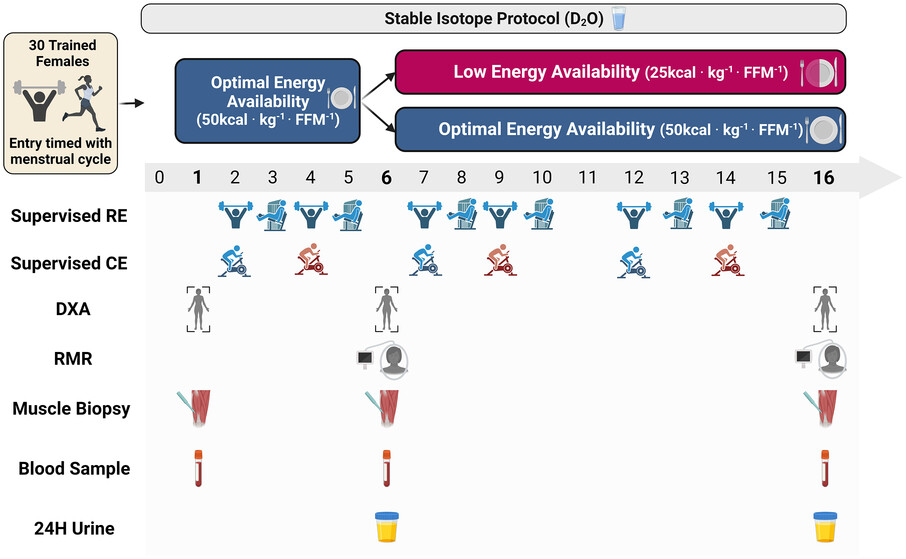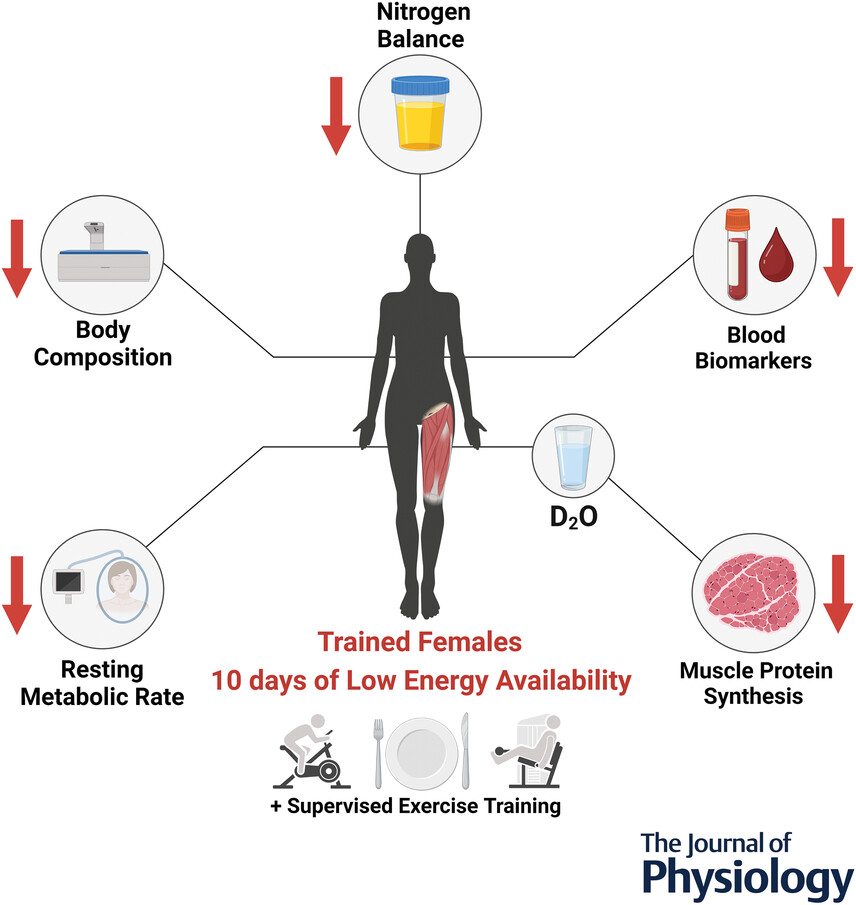
Why it’s time to shift the focus from low weight and body image to improve female athletes’ physical and mental health
Mette Hansen, Aarhus University, Denmark
Female athletes are at an increased risk of not eating enough. The reported prevalence varies between sports and is estimated at 25 to 60% (Merlin, 2018), but can be as high as 50-80% for endurance athletes, such as runners and cyclists (Jesus et al, 2021). Training on a low-calorie intake could be harmful to the overall health and performance of the athletes. “The present knowledge strongly suggests that the longer the body is in a low energy availability state, where the calories consumed fail to meet an athlete’s energy needs for training, the more severe the health consequences will be. Some of which may be irreversible, such as low bone status,” states Mette Hansen, Aarhus University, Denmark. Hansen is a member of a team of muscle physiologists from Canada and Denmark, who explored the impact of nutrition on athletes’ muscles and metabolism. In this interview, Hansen tells us more about the research she and the team published in The Journal of Physiology, discussing the penalties of low energy availability for female athletes.
The interplay between nutrition and female physiology fascinates Hansen, “The intricate relationship has a profound impact on various aspects of women’s health, from puberty through to menopause,” she says. Societal pressures regarding body image for women, particularly in Western culture and media where a slender figure is heralded as the ideal body type, has led to a high prevalence of dieting and eating disorders (Dorian and Garfinkel, 2002). Hansen’s vision is to improve the well-being and quality of life for women throughout their various life stages.

The physiological impacts of nutrition
The interplay between nutrition and female physiology fascinates Hansen, “The intricate relationship has a profound impact on various aspects of women’s health, from puberty through to menopause,” she says. Societal pressures regarding body image for women, particularly in Western culture and media where a slender figure is heralded as the ideal body type, has led to a high prevalence of dieting and eating disorders (Dorian and Garfinkel, 2002). Hansen’s vision is to improve the well-being and quality of life for women throughout their various life stages.
To achieve this goal, she is researching the physiological impacts of nutrition in female athletes to increase awareness of the consequences of energy restriction, both in the short- and long-term. “I want to promote healthier and sustainable approaches to weight management for female athletes,” says Hansen.
A state of imbalance
Food provides our bodies with the energy to carry out basic functions, such as metabolism, immune function, and reproductive health. Most athletes will follow a rigorous diet and training programme to achieve the best sporting results. Generally, when athletes increase their training volume, they should increase their energy/calorie intake. Instead, studies show that female athletes seem to be relying on a low-calorie/energy intake that does not match their increased training demands (Jesus et al, 2021).
Energy availability is calculated as energy intake minus exercise energy expenditure used on training expressed relative to fat free body mass (FFM). “When the calories consumed are not enough to meet both the energy demands of exercise, and the energy needed to maintain normal bodily functions, it results in a condition known as low energy availability (LEA),” explains Hansen. “Low energy availability is particularly concerning for athletes and active individuals.” When the intake from food is insufficient to support an athlete’s energy needs, it could jeopardise their health and the ability of their muscles to respond to training. “Recognising and addressing LEA is crucial,” states Hansen.
“In the sporting world a dogma persists, especially in weight-bearing sports and aesthetic sports, that low weight/low fat percentage is the path to success and to winning medals,” warns Hansen. “It is important to challenge this dogma and get a more balanced view of this.” Hansen adds that focusing on weight loss could be the wrong approach for the mental and physical health of an athlete, and there could be healthier options to optimise performance.
High risk athletes
The prevalence of LEA among female athletes varies depending on the sport and the level of competition. It also depends on the methodology used by the researchers to investigate LEA.
LEA seems most common among endurance athletes, e.g. runners and cyclists, with studies reporting the prevalence rates as high as 50 – 80% (Mountjoy et al, 2023). Disciplines labelled as aesthetic sports, which includes gymnastics, ballet, and figure skating, studies have found that up to 60-70% of females may experience LEA at some point during their athletic careers (Mountjoy et al, 2023). The prevalence of LEA can range from 25-58% for wrestlers and rowers, classed as weight-class sports (Mountjoy et al, 2023). Across the general population of female athletes, the prevalence of LEA is estimated to be between 20-50%. Specific quantitative data on awareness levels are less frequently reported.
The trial: Reduced vs optimised energy intake
Hansen and the team carried out a trial in well-trained group of athletes of 30 women aged between 18 and 30 years old. “During an 18-day intervention period, we controlled and supervised all training sessions. We adjusted the diet plan for each participant, then weighed out their food and delivered it to them,” says Hansen. It was one of the first well-controlled studies to be carried out of, where both diet and training were regulated to this extent.
All participants were fed a balanced diet for five days. After this period, the participants were divided into two groups at random. Half of them were given a low-calorie/energy diet of 25 kcal/kg FFM + the energy used on exercise on the specific training days, to put the athletes at a low energy availability state (LEA group). The others received an optimal energy diet of 50 kcal/kg FFM + energy used on exercise on the specific training days, to provide the athletes with sufficient energy to cover their needs (control group). All participants drank doubly labelled water, which is concentrated with heavy water molecules (meaning each water molecule carries an extra neutron compared to normal water), enabling the team to detect and measure the protein synthesis and degradation in the whole body and in the muscles (See Fig.1).
Over 10 days, both groups performed the same exercise programme, involving high-intensity training and resistance exercise sessions for the upper or lower body (See Fig.1). “We tested participants’ sporting performance, changes in resting metabolic rate, and several other outcomes, such as body mass and muscle response,” says Hansen.

Figure 1. Overview of intervention period showing the two diets (low vs optimal) consumed by the groups (LEA vs control) and the exercise programme of cardiovascular and resistance training (blue icon indicates moderate-intensity training and red icon indicates high-intensity interval training).
Reduced muscle gains
10 days consuming a low-calorie diet/low energy intake impaired the muscle-building response to training measured as a lower synthesis rate of muscle proteins. Lean body mass and metabolic resting rate were also reduced for the LEA group, along with changes in the hormonal system, such as a decrease in thyroid hormones, which slowed down the rate of metabolism (See Fig.2).
Despite the differences in energy intake between the low vs optimised diets for the LEA and control group, all participants consumed a protein-rich diet, containing 2.2 grams of protein per kilogram of lean body mass per day. “Even though the groups received the same amount of building block amino acids, the LEA group experienced a decline in muscle protein synthesis, while the control group experienced a significant increase. In line with this, the LEA experience a decline in lean body mass while the control group increased lean body mass. So, the low-calorie/energy diet had a degenerative effect on muscle mass, which negatively affected the muscles’ ability to respond to the training,” explains Hansen.

Figure 2. Illustrates the negative consequences of inadequate energy availability for female athletes. These impairments were recorded after 10 days of athletes training at a low energy availability state from consuming a low calorie diet that was insufficient to match the body’s energy needs to meet the training demands.
Poor sporting performance
As well as health, sporting performance was also poorer for the LEA group, who did worse than the control group in the repeated sprint ability, 4-min time-trial performance, and the force rate development of knee extensors tests. Hansen explains that the muscle glycogen level was lowered in the LEA group, which may partly explain the lower performance capacity after the LEA period. Muscle glycogen is the main source of fuel for muscles, when the fuel levels are drained, it prevents the muscles functioning as efficiently.
The physical impairments for the LEA group were partially restored after two days of recovery, which involved eating an energy sufficient diet. However, sporting performance was still inferior compared to the control group, who had eaten the diet optimised for energy availability during the whole 18-intervention period. The resting metabolic rate for the LEA group stayed at a lower rate after two days recovery. “This indicates that the body was still in a body-battery saver mode where basic metabolic functions are compromised,” says Hansen.
Challenging the dogma
“Our findings challenge the dogma that aiming at lowering the body weight/fat percentage in the weeks up to a competition seems not to be a medal winning strategy. Actually, we found the opposite that weight loss negatively impacted the body’s system, including muscles, and training results (Oxfeldt et al, 2023).” Hansen is hopeful that the health consequences highlighted in the study could help raise awareness and educate athletes, coaches and trainers to combat the high prevalence of LEA in sport.
There are still many questions that have yet to be answered on how women’s bodies react to inadequate energy intake. Hansen would like to explore the individual difference in the responsiveness to LEA and develop effective strategies to reverse the mental and physiological consequences of the condition.
“We need good biomarkers to detect which athletes, this includes both females and males, are at risk of developing a problematic degree of LEA. As for many other health issues, prevention is the way forward, since treatment of long-term LEA can be difficult.”
Hansen adds that the research findings could provide more personalised and effective guidance to female athletes. “I want to help female athletes shift their focus from detrimental energy restriction to optimising their adaptation to their training programme to enhance their sporting performance.”
Read the full research article ‘Low energy availability reduces myofibrillar and sarcoplasmic muscle protein synthesis in trained females’ published in The Journal of Physiology.
References
Dorian L & Garfinkel, PE. (2002). Culture and body image in Western culture. Eating and Weight Disorders, 7(1), 1–19. https://psycnet.apa.org/record/2002-02372-001
Jesus F et al. (2021). Risk of Low Energy Availability among Female and Male Elite Runners Competing at the 26th European Cross-Country Championships. Nutrients, 13(3), 873; https://doi.org/10.3390/nu13030873
Melin AK et al (2015). Energy Availability in Athletics: Health, Performance, and Physique. International Journal of Sport Nutrition and Exercise Metabolism https://doi.org/10.1123/ijsnem.2018-0201 https://journals.humankinetics.com/view/journals/ijsnem/29/2/article-p152.xml
Mountjoy M et al (2023). International Olympic Committee’s (IOC) consensus statement on Relative Energy Deficiency in Sport (REDs). Br J Sports Med, 57(17):1073-1097. doi: 10.1136/bjsports-2023-106994.
Oxfeldt M et al (2023). Low Energy Availability Followed by Optimal Energy Availability Does Not Benefit Performance in Trained Females. Med Sci Sports Exerc, 56(5):902-916. doi: 10.1249/MSS.0000000000003370. https://pubmed.ncbi.nlm.nih.gov/38181220/



